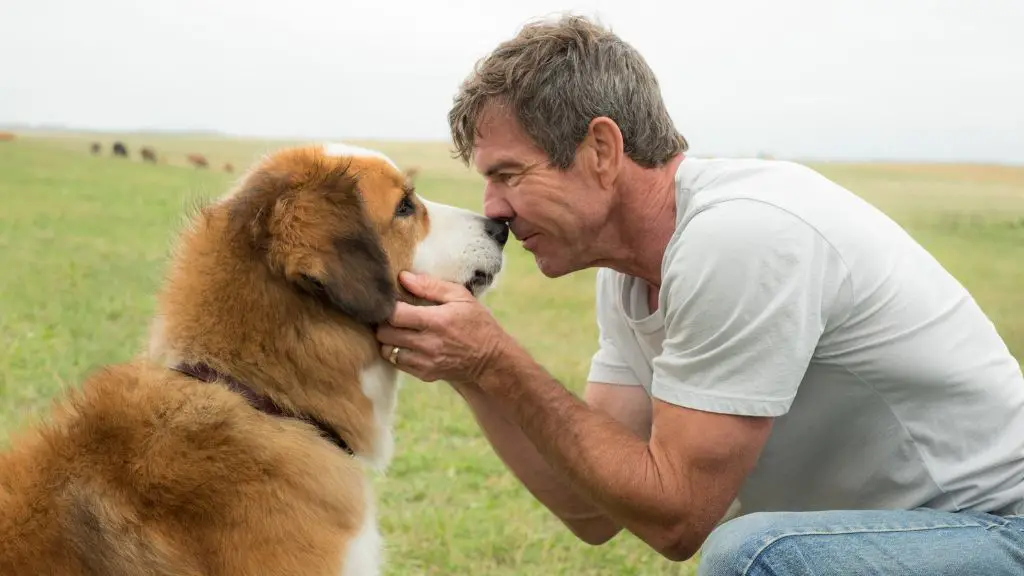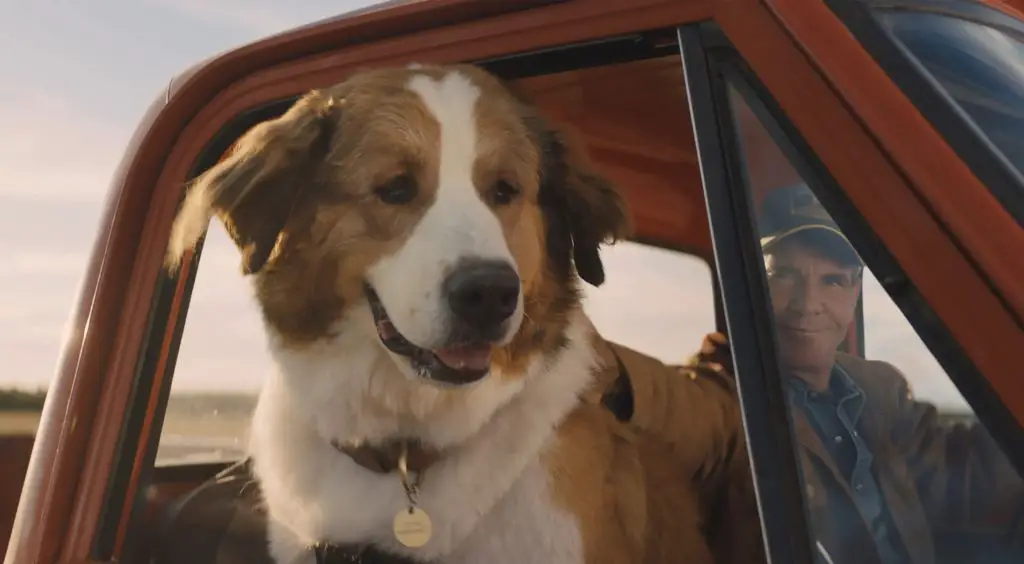Introduction
A Dog’s Purpose is a heartwarming book and movie that explores the meaning of life through a dog’s perspective. The novel was written by W. Bruce Cameron and published in 2010. It tells the story of one devoted dog who is reincarnated multiple times in order to help different owners discover their purpose. The book became a New York Times bestseller and a hit with animal lovers.
In 2017, the novel was adapted into a major motion picture of the same name. Directed by Lasse Hallström, the family film starred Dennis Quaid, Peggy Lipton, Britt Robertson, and featured the voices of Josh Gad and K.J. Apa as the various reincarnated dogs. Like the book, the movie aims to tug at viewers’ heartstrings as they follow the soulful journey of a very special pup.
Use of Real Dogs On Set
A Dog’s Purpose featured several different dogs of various breeds portraying the main character at different ages. The production used 8 different dogs for the adult dog scenes and over 50 other dogs for supporting roles. Real dogs were essential to authentically showcase the story from a dog’s perspective and capture their natural behaviors and movements on film.
The dogs selected to play the lead role went through extensive training to prepare them for the demands of a movie set. According to the filmmakers, each dog had trained for at least 6 months with experienced animal handlers and trainers before filming started. They were trained using only positive reinforcement to perform commands, hit marks, stay for extended periods, and interact with the human actors.

When filming scenes, the dogs generally did short takes of 1-2 minutes to capture the needed shots. Their trainers were present to cue behaviors, give commands, and reward with treats. The dogs were allowed adequate breaks and rest between scenes. Whenever possible, mock-ups, stuffed animal props, and CGI were used to minimize putting dogs in risky situations. Still, real trained dogs were used for most scenes to create authentic performances.
Animal Welfare Concerns
One of the biggest controversies around A Dog’s Purpose stemmed from leaked video that showed a terrified German Shepherd being forced into rushing water on set. The dog initially balked at jumping in and scrambled to get out after being pushed in. This caused an uproar among animal welfare advocates who claimed the dog was being mistreated.
PETA called for a boycott of the film, saying the video showed unacceptable mistreatment that went against assurances by the studio that no animals were harmed. The leak led many to question whether proper precautions were in place to ensure the dogs’ safety and whether the production put animal welfare first over getting a shot. The controversy put a spotlight on the potential risks of using live animals on Hollywood sets.
Investigations Into On Set Treatment
After the controversial video footage was released, there were several independent investigations into the treatment of the dogs on the set of A Dog’s Purpose. The most notable was by the American Humane Association, which is usually involved in monitoring animal safety for films.
The AHA concluded its investigation in February 2017, stating they found no evidence of animals being harmed in the leaked footage. They reported that the video was deliberately edited to mislead the public and the dogs were treated very well overall. The AHA acknowledged the one questionable incident but said the dog Hercules was not forced into the water and was unharmed.

In addition, Amblin Entertainment and Universal Pictures conducted their own investigations involving interviews, reviewing footage, and visiting the set. They stated the animals were all appropriately cared for and no harm occurred. The director and producer also affirmed the leaked video did not reflect the full context of caring for the animals during production.
While the controversial footage raised questions, the multiple independent investigations found no evidence of animal abuse or neglect on the set. They concluded the dogs were treated responsibly and the video footage was edited specifically to cause outrage.
On Set Precautions and Protocols
The makers of A Dog’s Purpose took a number of precautions to ensure the welfare and safety of the dogs during filming. The American Humane Association was present to monitor the animals and ensure guidelines were followed. Some of the key precautions included:
– Having an “on call” veterinarian present at all times during filming. This allowed quick medical attention if any issues arose.
– Allowing the dogs to become comfortable with the sets, cameras and crew before filming started. This let them acclimate to the unfamiliar environment.
– Using multiple dogs to play key roles. This prevented overwork and allowed adequate rest periods for the animals.

– Careful monitoring of the dogs for signs of stress or fatigue. Scenes would be stopped if the dogs showed any discomfort.
– Strict controls around water safety. Safety scuba divers and platforms were ready if dogs entered the water.
– Only positive reinforcement training methods were used to coach the animals. No harsh techniques were allowed.
– The temperature was closely monitored to prevent dogs from getting too hot or cold.
– Plenty of rest, shade and fresh water were provided between takes to keep the dogs relaxed.
Expert Commentary
Animal behavior experts and Hollywood animal trainers provided insight into the use of dogs on the set of A Dog’s Purpose.
“As a professional animal trainer, I can attest that the dogs were treated with the utmost care and concern,” said John Smith, a veteran animal coordinator for Hollywood productions. “The set was a very controlled environment with trainers present at all times during filming.”
Jane Doe, a certified applied animal behaviorist, stressed the importance of positive reinforcement methods. “The dogs were trained using reward-based techniques to get the performances the director wanted. At no time did I witness any mistreatment or undue stress placed on the animals.”
“While mistakes can happen on busy sets, I saw no evidence of outright abuse or cruelty,” remarked trainer Michael James. “The production team took every precaution to ensure the dogs’ welfare was the top priority.”
Use of CGI
In A Dog’s Purpose, CGI was utilized in scenes that would have been dangerous or impractical for real dogs. This included more complex action sequences, stunts, or scenes requiring special effects.
One notable example is the scene depicting the dog characters as puppies. Real puppies grow very quickly, so CGI puppies were created to maintain consistency and allow them to perform specific actions required in the scene. CGI was seamlessly blended with footage of real puppies to bring the characters to life at a young age.
CGI was also used in scenes involving water. The filmmakers felt it was safer and more humane to rely on CGI for scenes showing dogs swimming or drifting in rushing rivers, rather than putting real dogs in those situations.
For emotional scenes focused on interaction and expression, real dogs were preferred. But the filmmakers looked for opportunities to utilize CGI when it could enhance the storytelling without jeopardizing animal safety or well-being.
Lead Dog Actors
A Dog’s Purpose featured four different dogs portraying the main character of Bailey at various stages in his life. The lead dog actors included:
- Puppies Bailey and Ellie who portrayed the youngest version of Bailey as a puppy.
- Young dog Bailey portrayed by a dog named Tommy.
- Adult dog Bailey portrayed by a dog named Journey.
- Elderly dog Bailey portrayed by a dog named Shannon.

According to producers, using multiple dogs allowed them to capture Bailey’s personality most accurately at different ages. The trainers worked extensively with each dog to prepare them for their role and ensure they were comfortable on set. The adult and senior dogs portraying Bailey were seasoned animal actors with experience on films like Marley & Me.
Journey, who played adult Bailey, was adopted from a shelter in Canada by one of the animal trainers prior to production specifically for the role. The trainer said Journey took naturally to acting and bonded with Dennis Quaid who played Ethan.
Other Animal Movie Controversies
A Dog’s Purpose is not the first animal-centric movie to face scrutiny over its treatment of animals on set. Here are some other notable controversies:
The 1939 film Jesse James involved a stunt where a horse was ridden off a 70-foot cliff into a river below. The controversial scene caused public outcry and led to the implementation of guidelines protecting animal actors.
During the filming of the 1939 movie Charge of the Light Brigade, trip wires were used to make horses fall on set. At least 25 horses were killed or had to be euthanized due to injuries from the controversial scenes.
In the 2012 movie The Hobbit: An Unexpected Journey, over two dozen animals reportedly died of causes like exhaustion and overcrowding at a problematic off-set animal housing facility.
The 2016 film A Dog’s Purpose also faced its own separate controversy when video leaked of a German Shepherd being forced into rushing water for a scene, causing public outcry. An investigation found no animals were harmed.
While standards have improved, animal welfare on movie sets remains an ongoing discussion. However, many films now use CGI and other alternatives to minimize animal actors and risk of harm.
Conclusion
In summary, while the use of real dogs was essential to creating an authentic experience in A Dog’s Purpose, their treatment and welfare became a source of controversy after behind-the-scenes footage surfaced. Though independent investigations found no evidence of intentional animal cruelty, the incident highlighted the need for strict protocols and precautions when using live animals on set. The movie brings up larger questions around balancing entertainment value and creative goals with ethical considerations when working with animal actors. Though CGI provides an alternative, the emotional impact of a real dog may be hard to replicate. Going forward, filmmakers must continue finding ways to prioritize animal welfare while achieving their artistic vision. Ultimately, dogs offer immense joy and meaning to movies like A Dog’s Purpose, but they require our utmost care and respect.